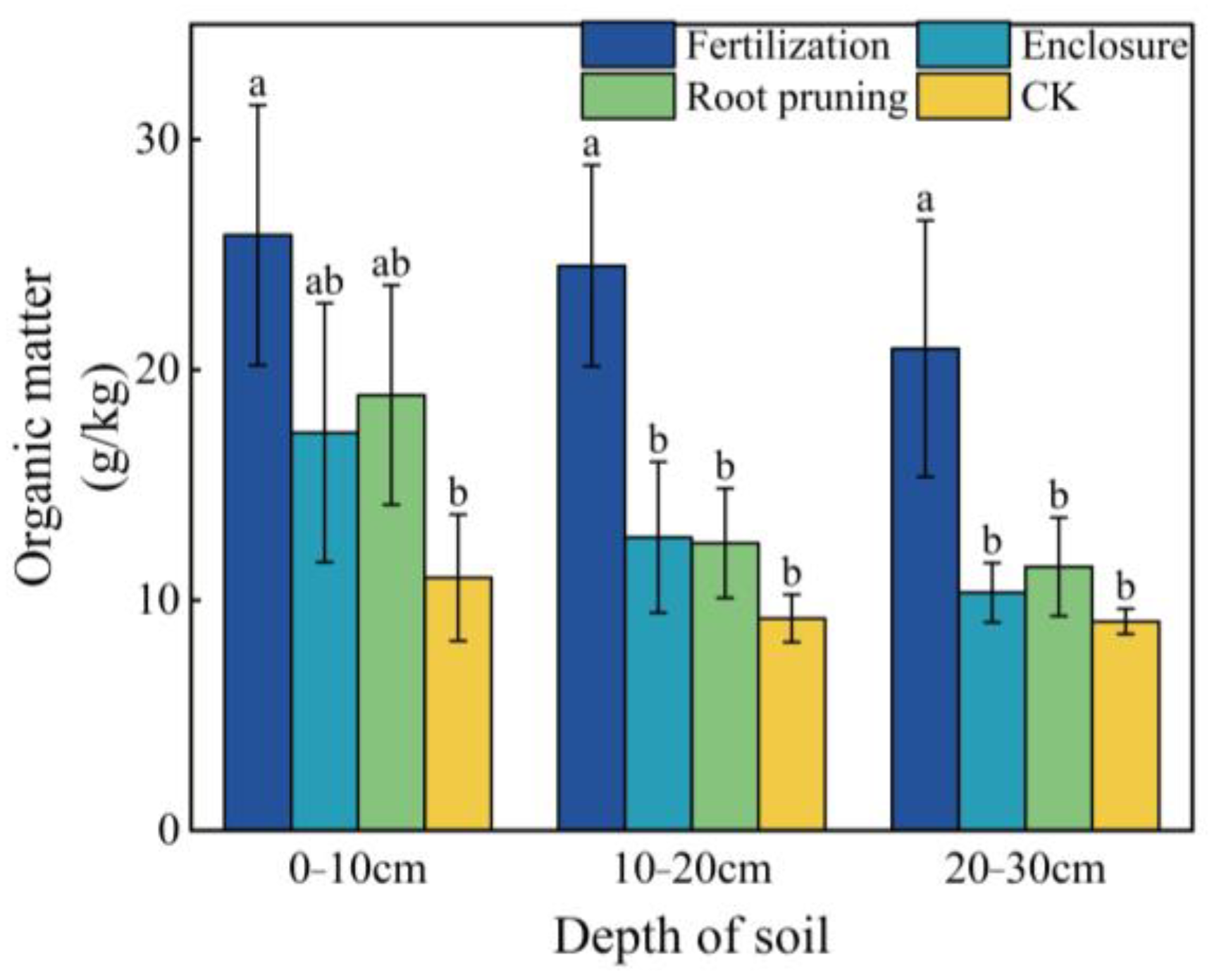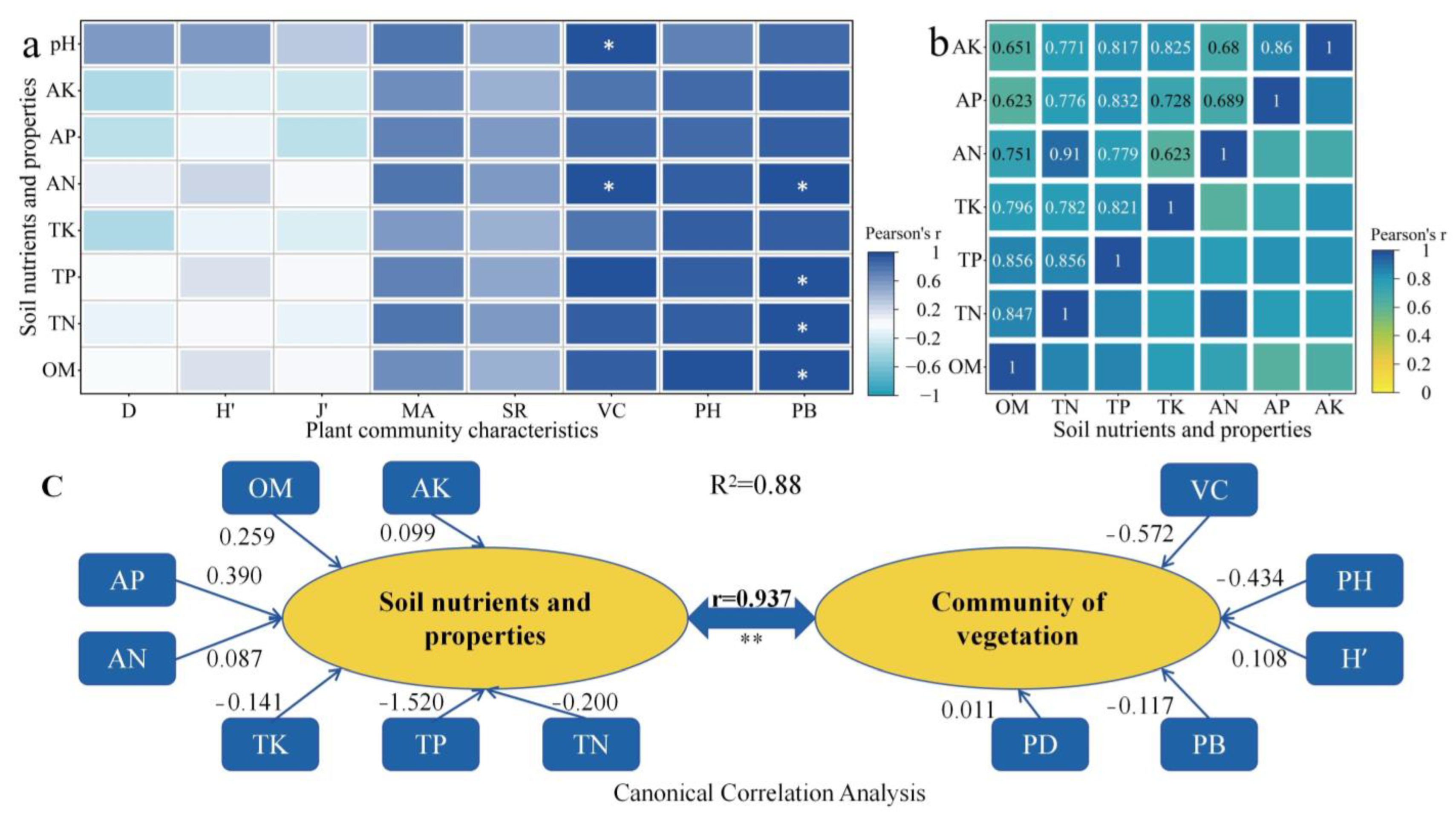Investigation into the Effects of Different Restoration Techniques on the Soil Nutrient Status in Degraded Stipa grandis Grassland
Abstract
:1. Introduction
2. Materials and Methods
2.1. Study Area Description
2.2. Experimental Design
2.3. Measurement Parameters
2.4. Statistical Analysis of Data
3. Results
3.1. Overall Characteristics of Soil Nutrients under Different Restoration Methods
3.2. Influence of Different Restoration Methods on the Soil Nutrient Content
3.2.1. Soil Organic Matter
3.2.2. Total Soil Nutrients
3.2.3. Soil available Nutrients
3.3. Correlation between Soil Nutrients and Vegetation Community
4. Discussion
4.1. Mechanisms of the Effects of Different Restoration Methods on Soil Organic Matter
4.2. Mechanisms of the Effects of Different Restoration Methods on Soil Total Nutrients
4.3. Mechanisms of the Effects of Different Restoration Methods on Soil Available Nutrients
4.4. Mechanisms of the Relationship between Soil Nutrients and Vegetation Community
5. Conclusions
Supplementary Materials
Author Contributions
Funding
Data Availability Statement
Acknowledgments
Conflicts of Interest
References
- Zhang, G.; Biradar, C.M.; Xiao, X.; Dong, J.; Zhou, Y.; Qin, Y.; Zhang, Y.; Liu, F.; Ding, M.; Thomas, R.J. Exacerbated Grassland Degradation and Desertification in Central Asia during 2000–2014. Ecol. Appl. 2018, 28, 442–456. [Google Scholar] [CrossRef]
- Miles, J. Review of Restoration Ecology. A Synthetic Approach to Ecological Research. J. Appl. Ecol. 1989, 26, 1096–1097. [Google Scholar] [CrossRef]
- Liu, J.; Lu, S.; Liu, C.; Hou, D. Nutrient Reallocation between Stem and Leaf Drives Grazed Grassland Degradation in Inner Mongolia, China. BMC Plant Biol. 2022, 22, 505. [Google Scholar] [CrossRef] [PubMed]
- Wu, Y.; Zhou, H.; Sun, W.; Zhao, Q.; Liang, M.; Chen, W.; Guo, Z.; Jiang, Y.; Jiang, Y.; Liu, G.; et al. Temperature Sensitivity of Soil Enzyme Kinetics under N and P Fertilization in an Alpine Grassland, China. Sci. Total Environ. 2022, 838, 156042. [Google Scholar] [CrossRef] [PubMed]
- Du, Z.; Xie, Y.; Hu, L.; Hu, L.; Xu, S.; Li, D.; Wang, G.; Fu, J. Effects of Fertilization and Clipping on Carbon, Nitrogen Storage, and Soil Microbial Activity in a Natural Grassland in Southern China. PLoS ONE 2014, 9, e99385. [Google Scholar] [CrossRef]
- Strecker, T.; Barnard, R.L.; Niklaus, P.A.; Scherer-Lorenzen, M.; Weigelt, A.; Scheu, S.; Eisenhauer, N. Effects of Plant Diversity, Functional Group Composition, and Fertilization on Soil Microbial Properties in Experimental Grassland. PLoS ONE 2015, 10, e0125678. [Google Scholar] [CrossRef]
- Berdahl, J.D.; Karn, J.F.; Hendrickson, J.R. Dry Matter Yields of Cool-Season Grass Monocultures and Grass–Alfalfa Binary Mixtures. Agron. J. 2001, 93, 463. [Google Scholar] [CrossRef]
- Sheaffer, C.C.; Miller, D.W.; Marten, G.C. Grass Dominance and Mixture Yield and Quality in Perennial Grass-Alfalfa Mixtures. J. Prod. Agric. 1990, 3, 480–485. [Google Scholar] [CrossRef]
- Xu, G.; Kang, X.; Li, W.; Li, Y.; Chai, Y.; Wu, S.; Zhang, X.; Yan, Z.; Kang, E.; Yang, A.; et al. Different Grassland Managements Significantly Change Carbon Fluxes in an Alpine Meadow. Front. Plant Sci. 2022, 13, 1000558. [Google Scholar] [CrossRef]
- Liu, X.; Ma, Z.; Huang, X.; Li, L. How Does Grazing Exclusion Influence Plant Productivity and Community Structure in Alpine Grasslands of the Qinghai-Tibetan Plateau? Glob. Ecol. Conserv. 2020, 23, e01066. [Google Scholar] [CrossRef]
- Wang, Y.; Ren, Z.; Ma, P.; Wang, Z.; Niu, D.; Fu, H.; Elser, J.J. Effects of Grassland Degradation on Ecological Stoichiometry of Soil Ecosystems on the Qinghai-Tibet Plateau. Sci. Total Environ. 2020, 722, 137910. [Google Scholar] [CrossRef] [PubMed]
- Nelson, D.W. Total Carbon, Organic Carbon, and Organic Matter; American Society of Agronomy: Madison WI, USA, 1996. [Google Scholar]
- Sader, A.P.O.; Oliveira, S.G.; Berchielli, T.T. Application of kjeldahl and dumas combustion methods for nitrogen analysis. Arch. Vet. Sci. 2004, 9. [Google Scholar] [CrossRef]
- Chen, Y.; Jia, J.; Wu, C.; Ramirez-Granada, L.; Li, G. Estimation on Total Phosphorus of Agriculture Soil in China: A New Sight with Comparison of Model Learning Methods. J. Soils Sediments 2023, 23, 998–1007. [Google Scholar] [CrossRef]
- Hald, P.M.; Mason, W.B. Sodium and Potassium by Flame Photometry. In Standard Methods of Clinical Chemistry; Seligson, D., Ed.; Elsevier: New York, NY, USA; London, UK, 1958; Volume 2, pp. 165–185. [Google Scholar]
- Xingwu, D.; Liu, B.; Gu, Z.; Rong, L.; Feng, D. Quantifying Soil Erosion Effects on Soil Productivity in the Dry-Hot Valley, Southwestern China. Environ. Earth Sci. 2016, 75, 1164. [Google Scholar] [CrossRef]
- Qu, G.; Chen, B.; Zhang, D.; Wu, F.; Jin, C.; Li, H.; Liu, S.; Li, Y.; Qin, J. Pollutants’ Migration and Transformation Behavior in Phosphorus Ore Flotation Tailings Treated with Different Additives. Appl. Geochem. 2022, 143, 105358. [Google Scholar] [CrossRef]
- Potdar, R.; Shirolkar, M.; Verma, A.; More, P.; Kulkarni, A. Determination of Soil Nutrients (NPK) Using Optical Methods: A Mini Review. J. Plant Nutr. 2021, 44, 1826–1839. [Google Scholar] [CrossRef]
- Raza, T.; Qadir, M.F.; Khan, K.S.; Eash, N.S.; Yousuf, M.; Chatterjee, S.; Manzoor, R.; Rehman, S.; Oetting, J.N. Unrevealing the Potential of Microbes in Decomposition of Organic Matter and Release of Carbon in the Ecosystem. J. Environ. Manag. 2023, 344, 118529. [Google Scholar] [CrossRef]
- Bulseco, A.N.; Giblin, A.E.; Tucker, J.; Murphy, A.E.; Bowen, J.L. Nitrate Addition Stimulates Microbial Decomposition of Organic Matter in Salt Marsh Sediments. Glob. Chang. Biol. 2019, 25, 3224–3241. [Google Scholar] [CrossRef]
- Middleton, B.A. Trends of Litter Decomposition and Soil Organic Matter Stocks across Forested Swamp Environments of the Southeastern US. PLoS ONE 2020, 15, e0226998. [Google Scholar] [CrossRef]
- Qian, Z.; Zhuang, S.; Gao, J.; Tang, L.; Harindintwali, J.D.; Wang, F. Aeration Increases Soil Bacterial Diversity and Nutrient Transformation under Mulching-Induced Hypoxic Conditions. Sci. Total Environ. 2022, 817, 153017. [Google Scholar] [CrossRef]
- Zhao, Q.; Thompson, A.M.; Callister, S.J.; Tfaily, M.M.; Bell, S.L.; Hobbie, S.E.; Hofmockel, K.S. Dynamics of Organic Matter Molecular Composition under Aerobic Decomposition and Their Response to the Nitrogen Addition in Grassland Soils. Sci. Total Environ. 2022, 806, 150514. [Google Scholar] [CrossRef]
- Lladó, S.; López-Mondéjar, R.; Baldrian, P. Forest Soil Bacteria: Diversity, Involvement in Ecosystem Processes, and Response to Global Change. Microbiol. Mol. Biol. Rev. 2017, 81, e00063-16. [Google Scholar] [CrossRef]
- Baslam, M.; Mitsui, T.; Sueyoshi, K.; Ohyama, T. Recent Advances in Carbon and Nitrogen Metabolism in C3 Plants. Int. J. Mol. Sci. 2020, 22, 318. [Google Scholar] [CrossRef]
- Zhou, W.; Lv, H.; Chen, F.; Wang, Q.; Li, J.; Chen, Q.; Liang, B. Optimizing Nitrogen Management Reduces Mineral Nitrogen Leaching Loss Mainly by Decreasing Water Leakage in Vegetable Fields under Plastic-Shed Greenhouse. Environ. Pollut. 2022, 308, 119616. [Google Scholar] [CrossRef]
- Yin, J.; Li, D.; Yu, J.; Bai, X.; Cui, W.; Liu, R.; Zhuang, M. Environmental and Economic Benefits of Substituting Chemical Potassium Fertilizer with Crop Straw Residues in China. Environ. Sci. Pollut. Res. 2022, 30, 30603–30611. [Google Scholar] [CrossRef]
- Datta, R.; Kelkar, A.; Baraniya, D.; Molaei, A.; Moulick, A.; Meena, R.S.; Formanek, P. Enzymatic Degradation of Lignin in Soil: A Review. Sustainability 2017, 9, 1163. [Google Scholar] [CrossRef]
- Gai, X.; Li, S.; Zhang, X.; Bian, F.; Yang, C.; Zhong, Z. Changes in Soil Phosphorus Availability and Associated Microbial Properties after Chicken Farming in Lei Bamboo (Phyllostachys Praecox) Forest Ecosystems. Land Degrad. Dev. 2021, 32, 3008–3022. [Google Scholar] [CrossRef]
- Du, Y.; Niu, W.; Zhang, Q.; Cui, B.; Gu, X.; Guo, L.; Liang, B. Effects of Nitrogen on Soil Microbial Abundance, Enzyme Activity, and Nitrogen Use Efficiency in Greenhouse Celery under Aerated Irrigation. Soil Sci. Soc. Am. J. 2018, 82, 606–613. [Google Scholar] [CrossRef]
- Han, Y.; White, P.J.; Cheng, L. Mechanisms for Improving Phosphorus Utilization Efficiency in Plants. Ann. Bot. 2021, 129, 247–258. [Google Scholar] [CrossRef]
- Shenoy, V.V.; Kalagudi, G.M. Enhancing Plant Phosphorus Use Efficiency for Sustainable Cropping. Biotechnol. Adv. 2005, 23, 501–513. [Google Scholar] [CrossRef] [PubMed]





| Experimental Plot of Grassland Restoration | Detailed Description |
|---|---|
| Fertilization | Applying organic fertilizer to grassland to provide nutrients needed by plants, improve soil nutrition, and increase grass yield |
| Enclosure | Enclosure to prevent certain human intervention, livestock feeding, trampling, and other external interference, and to give the degraded grassland vegetation recovery opportunities |
| Root cutting | Under the condition of not destroying the natural grassland vegetation, it is a kind of grassland restoration measure to break the soil and cut the seam on the grassland epidermis |
| Control group | Degraded grassland |
| Analysis | Analysis Method |
|---|---|
| Organic matter (OM) | Potassium dichromate oxidation with external heating method [12] |
| Total nitrogen (TN) | Dumas combustion method [13] |
| Total phosphorus (TP) | Alkali fusion–Mo-Sb anti-spectrophotometric method [14] |
| Total potassium (TK) | Sodium hydroxide fusion-flame photometry [15] |
| Available nitrogen (AN) | Alkali N-proliferation method [16] |
| Available phosphorus (AP) | Sodium hydrogen carbonate solution-Mo-Sb anti-spectrophotometric method [17] |
| Available potassium (AK) | Ammonium acetate solution extraction with flame photometry [18] |
Disclaimer/Publisher’s Note: The statements, opinions and data contained in all publications are solely those of the individual author(s) and contributor(s) and not of MDPI and/or the editor(s). MDPI and/or the editor(s) disclaim responsibility for any injury to people or property resulting from any ideas, methods, instructions or products referred to in the content. |
© 2023 by the authors. Licensee MDPI, Basel, Switzerland. This article is an open access article distributed under the terms and conditions of the Creative Commons Attribution (CC BY) license (https://creativecommons.org/licenses/by/4.0/).
Share and Cite
Zhang, P.; Yu, T.; Shan, D.; Yan, R.; Zhang, L.; Wang, J.; Wuren, Q. Investigation into the Effects of Different Restoration Techniques on the Soil Nutrient Status in Degraded Stipa grandis Grassland. Agronomy 2024, 14, 57. https://doi.org/10.3390/agronomy14010057
Zhang P, Yu T, Shan D, Yan R, Zhang L, Wang J, Wuren Q. Investigation into the Effects of Different Restoration Techniques on the Soil Nutrient Status in Degraded Stipa grandis Grassland. Agronomy. 2024; 14(1):57. https://doi.org/10.3390/agronomy14010057
Chicago/Turabian StyleZhang, Peiqing, Tianqi Yu, Dan Shan, Ruirui Yan, Lianyun Zhang, Junjie Wang, and Qiqige Wuren. 2024. "Investigation into the Effects of Different Restoration Techniques on the Soil Nutrient Status in Degraded Stipa grandis Grassland" Agronomy 14, no. 1: 57. https://doi.org/10.3390/agronomy14010057
APA StyleZhang, P., Yu, T., Shan, D., Yan, R., Zhang, L., Wang, J., & Wuren, Q. (2024). Investigation into the Effects of Different Restoration Techniques on the Soil Nutrient Status in Degraded Stipa grandis Grassland. Agronomy, 14(1), 57. https://doi.org/10.3390/agronomy14010057







